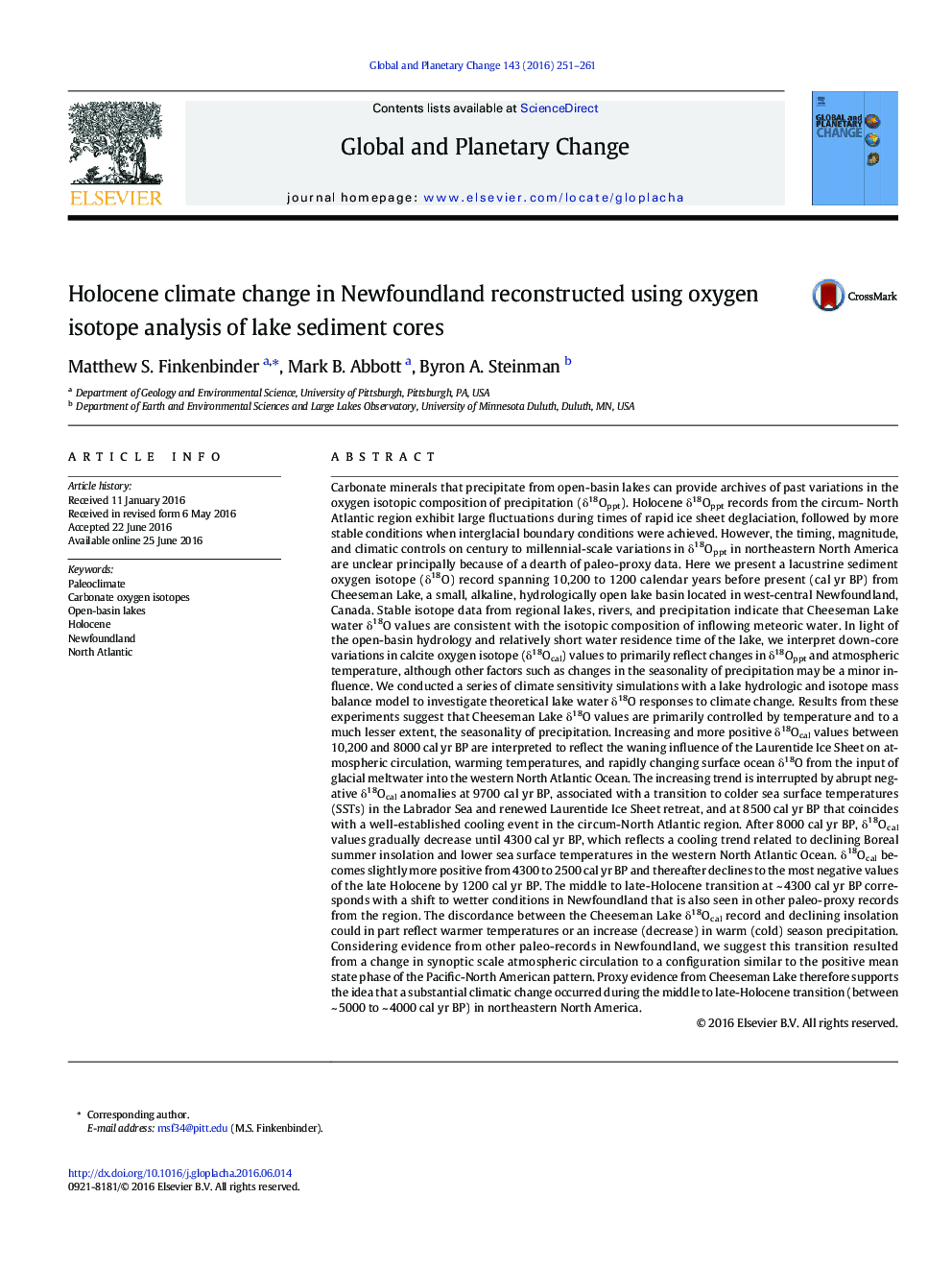| کد مقاله | کد نشریه | سال انتشار | مقاله انگلیسی | نسخه تمام متن |
|---|---|---|---|---|
| 4463306 | 1621639 | 2016 | 11 صفحه PDF | دانلود رایگان |
• Newfoundland lake sediments reveal Holocene hydroclimate variability.
• Oxygen isotope record reflects changes in precipitation isotope values.
• Climate sensitive to North Atlantic Ocean-atmosphere variability.
• Early Holocene warming interrupted by abrupt cooling.
• Middle Holocene shift in atmospheric circulation occurs at ~ 4300 cal yr BP.
Carbonate minerals that precipitate from open-basin lakes can provide archives of past variations in the oxygen isotopic composition of precipitation (δ18Oppt). Holocene δ18Oppt records from the circum- North Atlantic region exhibit large fluctuations during times of rapid ice sheet deglaciation, followed by more stable conditions when interglacial boundary conditions were achieved. However, the timing, magnitude, and climatic controls on century to millennial-scale variations in δ18Oppt in northeastern North America are unclear principally because of a dearth of paleo-proxy data. Here we present a lacustrine sediment oxygen isotope (δ18O) record spanning 10,200 to 1200 calendar years before present (cal yr BP) from Cheeseman Lake, a small, alkaline, hydrologically open lake basin located in west-central Newfoundland, Canada. Stable isotope data from regional lakes, rivers, and precipitation indicate that Cheeseman Lake water δ18O values are consistent with the isotopic composition of inflowing meteoric water. In light of the open-basin hydrology and relatively short water residence time of the lake, we interpret down-core variations in calcite oxygen isotope (δ18Ocal) values to primarily reflect changes in δ18Oppt and atmospheric temperature, although other factors such as changes in the seasonality of precipitation may be a minor influence. We conducted a series of climate sensitivity simulations with a lake hydrologic and isotope mass balance model to investigate theoretical lake water δ18O responses to climate change. Results from these experiments suggest that Cheeseman Lake δ18O values are primarily controlled by temperature and to a much lesser extent, the seasonality of precipitation. Increasing and more positive δ18Ocal values between 10,200 and 8000 cal yr BP are interpreted to reflect the waning influence of the Laurentide Ice Sheet on atmospheric circulation, warming temperatures, and rapidly changing surface ocean δ18O from the input of glacial meltwater into the western North Atlantic Ocean. The increasing trend is interrupted by abrupt negative δ18Ocal anomalies at 9700 cal yr BP, associated with a transition to colder sea surface temperatures (SSTs) in the Labrador Sea and renewed Laurentide Ice Sheet retreat, and at 8500 cal yr BP that coincides with a well-established cooling event in the circum-North Atlantic region. After 8000 cal yr BP, δ18Ocal values gradually decrease until 4300 cal yr BP, which reflects a cooling trend related to declining Boreal summer insolation and lower sea surface temperatures in the western North Atlantic Ocean. δ18Ocal becomes slightly more positive from 4300 to 2500 cal yr BP and thereafter declines to the most negative values of the late Holocene by 1200 cal yr BP. The middle to late-Holocene transition at ~ 4300 cal yr BP corresponds with a shift to wetter conditions in Newfoundland that is also seen in other paleo-proxy records from the region. The discordance between the Cheeseman Lake δ18Ocal record and declining insolation could in part reflect warmer temperatures or an increase (decrease) in warm (cold) season precipitation. Considering evidence from other paleo-records in Newfoundland, we suggest this transition resulted from a change in synoptic scale atmospheric circulation to a configuration similar to the positive mean state phase of the Pacific-North American pattern. Proxy evidence from Cheeseman Lake therefore supports the idea that a substantial climatic change occurred during the middle to late-Holocene transition (between ~ 5000 to ~ 4000 cal yr BP) in northeastern North America.
Journal: Global and Planetary Change - Volume 143, August 2016, Pages 251–261
